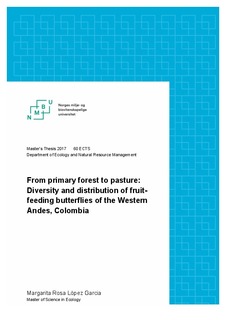| dc.description.abstract | Tropical forests are under immense pressure from agricultural expansion and other
human disturbances, and the deforestation leads to forest fragmentation and
accelerated biodiversity loss. The tropical Andes of Colombia, a global biodiversity
hotspot, is an area that has undergone severe land-use change and where the remaining
primary forest is highly fragmented. Previous studies show that this land-use change
and fragmentation of primary forest have severely affects a variety of different
taxonomic groups. Yet, apart from for dung beetles, no study to date has assessed the
impacts of land-use change on insects in the Colombian Andes. Fruit-feeding butterflies
are good candidates to study effects of land-use change because they are easy to capture,
and they are relatively well known taxonomically and ecologically. Butterflies are also
an indicator taxon, used to measure ecosystem health. Here I examine the patterns of
fruit-feeding butterfly assemblage structure and composition along an altitudinal
gradient (1319-2683 masl) in primary forest, secondary forest and pasture in the
western Andes of Colombia. Fruit-feeding butterflies were sampled using baited
butterfly traps in 400 x 400m squares distributed across the three habitats. Each square
contained 10 traps and a total of 30 squares were sampled. I found that pasture
contained the highest species richness and abundance, largely dominated by Satyrinae
butterflies. However, primary and secondary forests were more diverse and had a
similar species composition. Pasture assemblages were significantly different to those of
primary and secondary forest. Altitude significantly affected butterfly abundance, but
not richness, across the habitats. In addition, several species had a very narrow
altitudinal range at the very lowest elevations, perhaps suggesting that these species
belong to the lowlands and are at their altitudinal limits. The results show that butterfly
assemblages are severely affected by land-use change. However, the fact that secondary
forests contain a similar species composition to that of primary forest suggests that
secondary forest retain significant biodiversity and plays a vital role in supporting
biodiversity in regions where most of the primary forest has been lost. It also suggests
that secondary forests are recovering towards a primary forest state. I therefore
conclude that primary forests should be a conservation priority in the region, but
investing in secondary forest recovery by reforesting marginally profitable cattle
pastures may be a good way to aid the protection of the highly endangered biota across
the Andes. | nb_NO |

